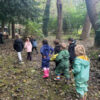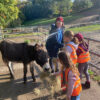by Antonia Beary
Headmistress, Mayfield School
Teachers from my own schooldays might be rather sceptical at my writing an article on the benefits of sport, and rightly so, as any recollections of my youthful endeavours to avoid cross country or the 1500 metres (I think I was the only person in my year not to do it) would elicit, at best, amusement. However, even the most recalcitrant child can surprise themselves and others.
Sport teaches us all, not just our children, skills and helps discover abilities which can prove invaluable as life skills. Playing as a team requires not only working together, but thinking about other people and understanding their strengths and weaknesses.
Good team players will be able to see themselves contributing to something bigger, as they have to look beyond their own individual goals to the shared, common good. Representing our school, or county or country, requires stepping up to the mark and working towards an altruistic goal, espousing what may seem old-fashioned values, which are increasingly at odds with those of the self-centred society in which we seem to live. Most of us can’t avoid having to work with others, so acquiring the tools to do it well, and sooner rather than later, is key. For teenagers to appreciate both that it is not just ‘all about them’ but also that they have something valuable to contribute, promotes a balanced sense of self-esteem.
Practice, as we know, makes perfect. In a world where there is a disproportionate focus on individuals plucked out of obscurity allegedly to fame and fortune, sport offers an excellent lesson: while natural ability may be an advantage, it is nothing without consistent effort and application – rain or shine. With our increasing dependence on mobile phones allowing the best laid plans to be changed at the last minute, understanding the concept of commitment to a match or practice is important. It doesn’t matter if you have a better offer – you have a responsibility to your team. In making sacrifices, so character is built. Captaining a team can lead on to more significant leadership roles and the responsibility being a role model entails.
Everyone seems to have an opinion about resilience: learning how to win and, more importantly, how to lose graciously are skills which should not be underrated. At a time when, increasingly, pressure is put on our children with an expectation they will always get things right, sport provides an arena where it is almost impossible not to make mistakes. Playing sport offers opportunities to learn how to cope when,
inevitably, things do not go to plan. Learning to roll with the punches – literal and metaphorical – is a vital skill. At the same time, having to conform to a set of rules is no bad thing for a child who is used to always getting what he – or she – wants. Fair play and respect for the umpire’s decision needs to be learnt and can’t necessarily be assumed: while cheats may well prosper in the world we live in, it doesn’t mean we should encourage or condone flouting of the rules. Sport should help instil in our young people the fundamental value of integrity.
There’s a reason why the Romans believed ‘Mens sana in corpore sano’. Computer games may offer a certain type of stimulation but there is nothing to beat fresh air and physical activity for real well-being. There is no escaping the fact that an increase in the availability of junk foods or, at the very least, overly processed foods, and less curriculum time devoted to sport is contributing to obesity in today’s young people. Not only does eating healthily help you perform better, but regular physical activity also means that you can get away with spoiling yourself every now and then. Moving to work in a boys’ school, I learnt the value of rugby: one harsh winter I taught classes unable to play sport due to frozen pitches. The windows regularly steamed up with pent-up energy, bordering on aggression. Expending energy on the playing field whether you are a boy or a girl, in my experience, means that you can focus effectively on your academic study. Furthermore, the skills of concentration, focus and determination are easily transferrable and success in a match can boost confidence and instil a self-belief which in turn allows you to approach a challenging maths problem or a philosophical conundrum with more conviction.
 There is a reason why we ‘play’ sport – sport has to be about having fun. For some, that pleasure will come from being intensely competitive, for others simply in being part of something bigger than themselves and spending time with their friends, not so much in the pursuit of excellence, but to cement relationships and support networks, to let
There is a reason why we ‘play’ sport – sport has to be about having fun. For some, that pleasure will come from being intensely competitive, for others simply in being part of something bigger than themselves and spending time with their friends, not so much in the pursuit of excellence, but to cement relationships and support networks, to let
off steam and relax after a stressful day.
And the joy of sport is that there is something for everyone. For the record: the girl who, aged 13, tried to arrange her music lessons in PE, in a few short years found herself representing Cambridge University in the Boat Race. Who says miracles don’t happen?
Antonia Beary is Headmistress of Mayfield School, a leading Catholic independent boarding and day school for girls aged 11 to 18 located in Sussex. Described by the Independent Schools Inspectorate as ‘outstanding’ and by Country Life as
“one of the finest schools in the land”,
a Mayfield education combines academic excellence, breadth of opportunity and exceptional pastoral care in a nurturing environment, which welcomes all.
For more information visit the school website at www.mayfieldgirls.org



 To begin, sit in easy pose, to promote inner calm. Imagine a balloon gently pulling your head up to sit a little taller, take in three deep breaths, counting to three on each breath in and three on each breath out. For the first few times you practice this with your child count aloud; that way they can then fully concentrate on their breathing. Focusing on the breath will help the mind begin to unwind and relax.
To begin, sit in easy pose, to promote inner calm. Imagine a balloon gently pulling your head up to sit a little taller, take in three deep breaths, counting to three on each breath in and three on each breath out. For the first few times you practice this with your child count aloud; that way they can then fully concentrate on their breathing. Focusing on the breath will help the mind begin to unwind and relax. Start on all fours, hands under shoulders, knees under hips. Cow – inhale and gently drop the belly towards the floor, lift the head and tailbone up towards the ceiling.
Start on all fours, hands under shoulders, knees under hips. Cow – inhale and gently drop the belly towards the floor, lift the head and tailbone up towards the ceiling. Cat – reverse the movement, exhaling deeply and round the spine, tucking the chin in towards the chest. If your child feels happy to do so, ask them to close their eyes as they do this.
Cat – reverse the movement, exhaling deeply and round the spine, tucking the chin in towards the chest. If your child feels happy to do so, ask them to close their eyes as they do this. Sit with your feet and heels touching. You can introduce some very gentle movement with the breath by lifting the knees up and down. You can, if you feel it is right for your child, encourage them to close their eyes and imagine they are a beautiful butterfly fluttering round their favourite park or place in nature.
Sit with your feet and heels touching. You can introduce some very gentle movement with the breath by lifting the knees up and down. You can, if you feel it is right for your child, encourage them to close their eyes and imagine they are a beautiful butterfly fluttering round their favourite park or place in nature. This is extremely self-soothing and helps to promote digestion, relieves stress and helps to calm the mind.
This is extremely self-soothing and helps to promote digestion, relieves stress and helps to calm the mind. This is another self-soothing posture. It increases circulation to the head and releases tension in the neck and back. Allow for the knees to come to the chest and clasp arms around the shin area of the leg. Gently rock side to side which gives a gentle bedtime massage to the spine.
This is another self-soothing posture. It increases circulation to the head and releases tension in the neck and back. Allow for the knees to come to the chest and clasp arms around the shin area of the leg. Gently rock side to side which gives a gentle bedtime massage to the spine.

 Wellingtons remained fashionable until the Duke’s death in 1853, but had declined in popularity by 1860 when the ankle boot finally superseded them. Nonetheless they continued to be worn by senior officers in the British Army, doing service in Crimea and the First World War.
Wellingtons remained fashionable until the Duke’s death in 1853, but had declined in popularity by 1860 when the ankle boot finally superseded them. Nonetheless they continued to be worn by senior officers in the British Army, doing service in Crimea and the First World War. Safety
Safety Meet new friends
Meet new friends












